Blog
November 17th, 2010
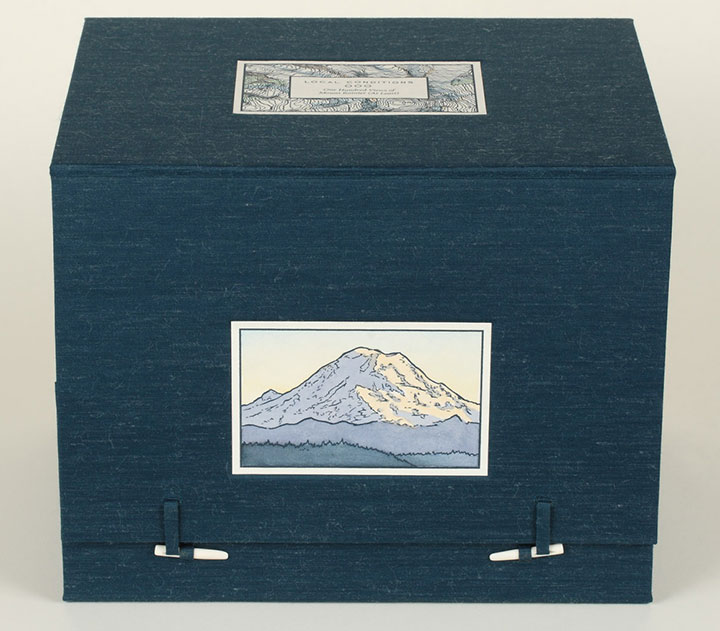
I’ve been hemming and hawing about how best to share this thing with you. Even with Sarah’s excellent photography, it’s just a lot more difficult to explain how it works when I can’t hold the book out into space and demonstrate in real time. It’s a problem with every artist book out there—an interactive sculpture, complete with moving parts, that also happens to tell a story is just dern hard to document.
So for now, I’m going to go through the mechanics of the thing, step by step, and go into the whys and wherefores in other posts. And for those of you who might not be familiar with the term artist book, you’re going to find out really quickly that this isn’t your basic hardcover book. The definition of “artist book” is way too broad to go into within this post (click the above link to go to what I wrote on my F.A.Q. about it), but I’m hoping that by the time you get to the bottom of this post, you’ll have an idea of just how broad the term can be—and what crazy things can happily fall into the category.
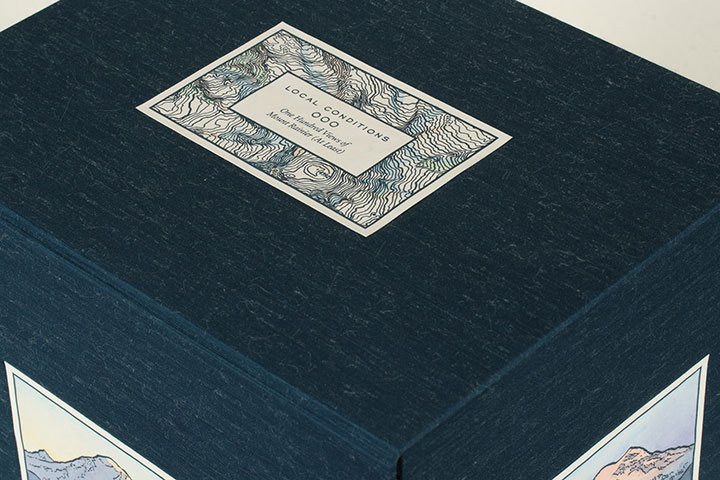
Okay, let’s start with the box. When it’s all closed up, Local Conditions is almost a cube (a 10-inch cube that’s heavy enough to be hiding a sack or two of flour inside). On the topmost face of the box is the frontispiece, containing the title and a topographic map illustration of the summit of Mt. Rainier.
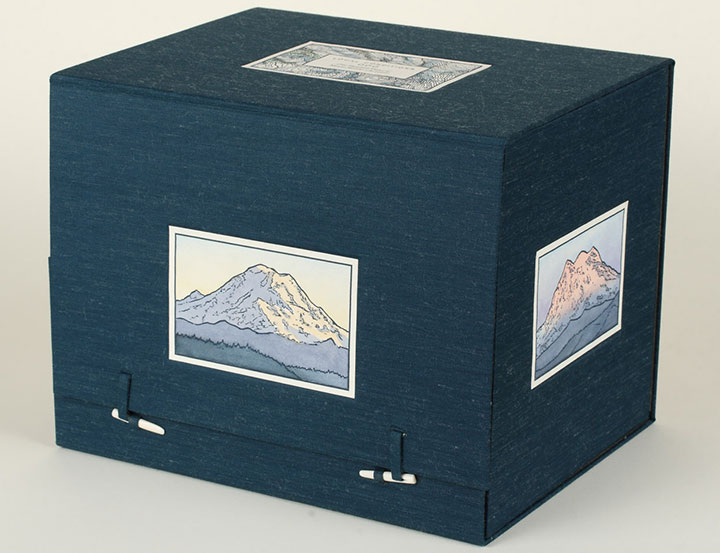
The north, south, east and west sides of the box are faced with illustrations of the corresponding faces of Rainier, each depicting the mountain at sunset.
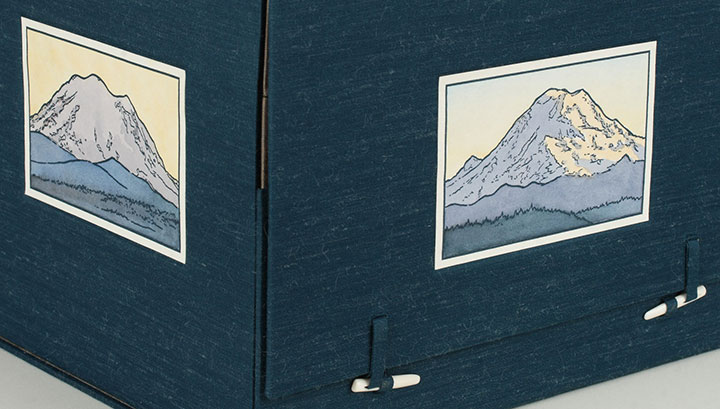
(That’s the eastern face on the left, and the north face beside it.)
Now, those two little bone clasps hold the thing together, and when you flick them out of their loops,
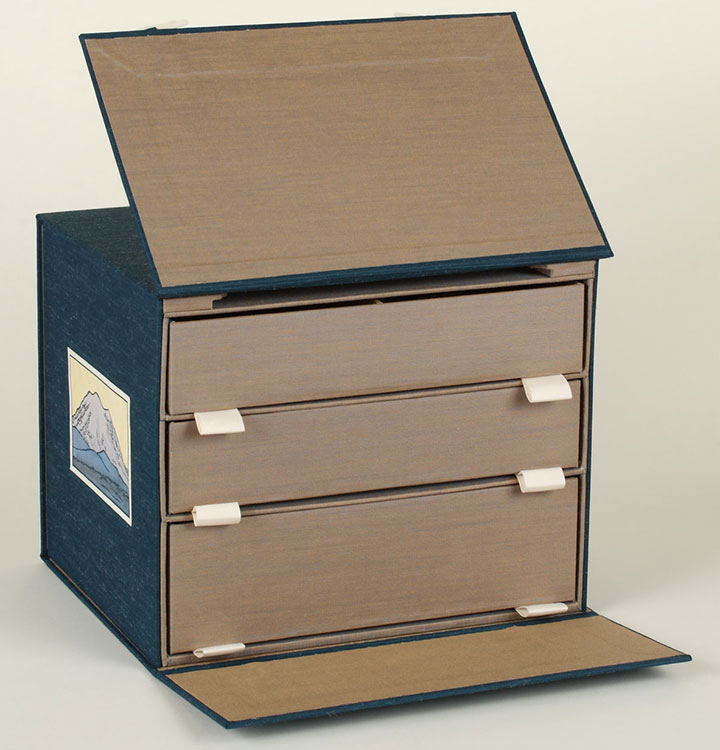
the book opens up, revealing a chest of drawers. Keep pulling on the flap you just raised,

and you’ll find that you can take the whole outer wrapper off and read the colophon (see below) printed on the inside.
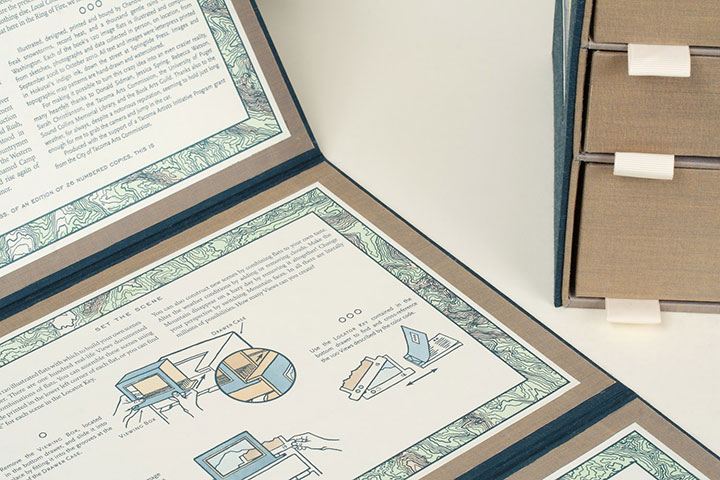
The other panels on the wrapper include detailed instructions on everything the book does.

Next, let’s open the drawers—nested in the bottom one you’ll find a Viewing Box (yeah, I know … a box, within a box, within a box … sorry.) that consists of a window, a background panel, and two tabs that stick out from either side.

The tabs match up with the grooved unit at the top of the chest of drawers, and the Viewing Box slides into place.

So now the box is fully expanded, and the book is assembled for use. Now comes the fun part.
Take a closer look at the Viewing Box, and open the top two drawers.

Inside the drawers you’ll find a series of cut-out cards, each printed with a different image. These little image flats slide right into the slots of the Viewing Box,
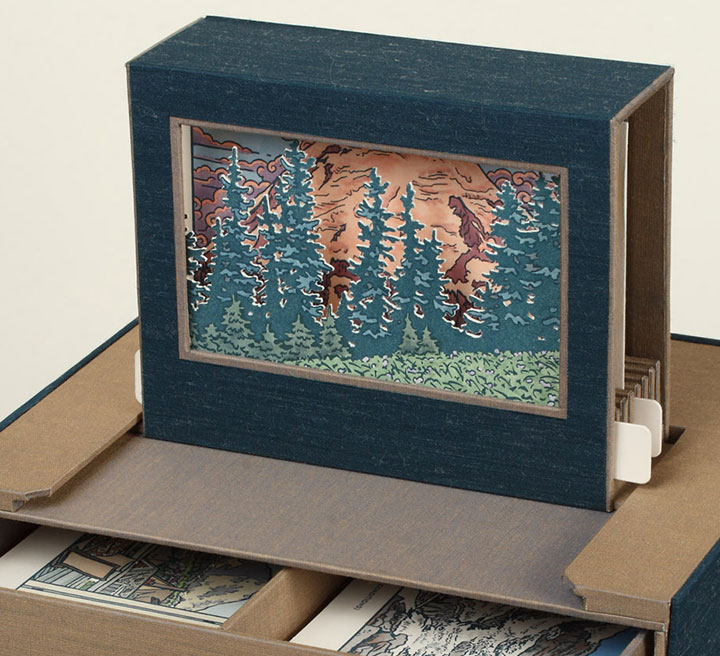
and face out the window to form an instant picture—kind of like an old-fashioned stage set.
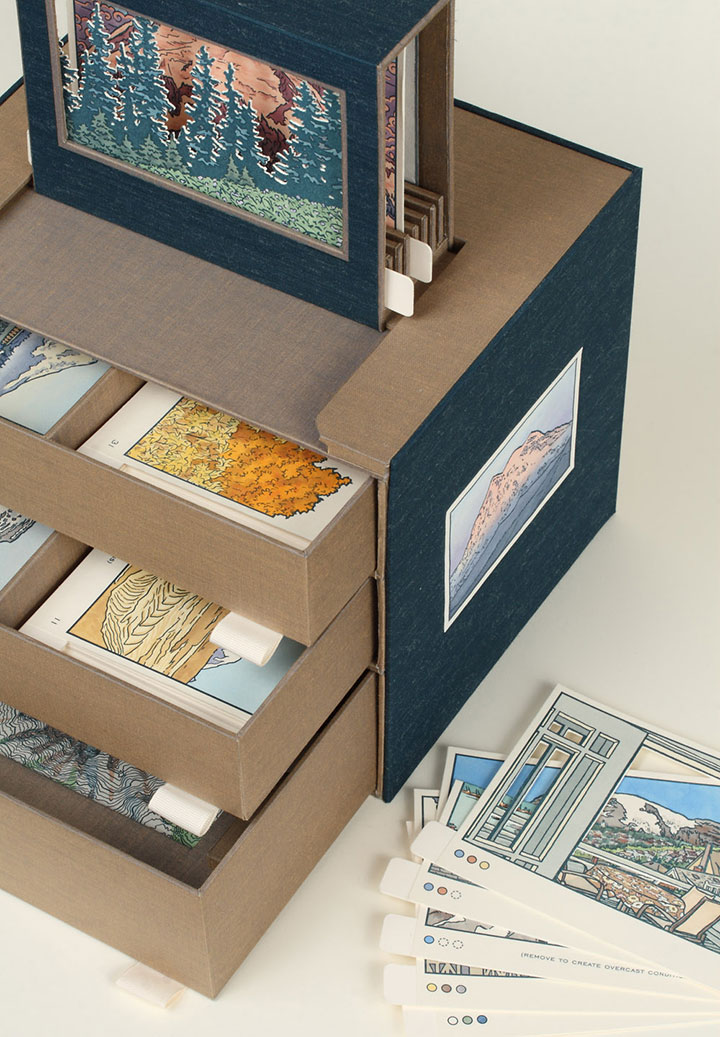
Now here’s the thing:
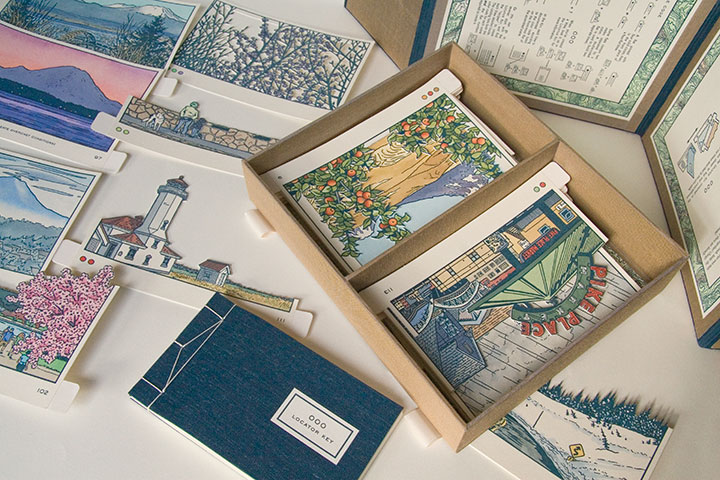
There are 120 flats to choose from. One hundred and twenty. Each one hand-printed, hand-painted, hand-cut.

By combining, layering and switching the flats in and out of the Viewing Box, you can create seemingly endless scenes of Mt Rainier. I came up with one hundred, and documented them as part of the book (again, I’ll elaborate later), but I’m more interested in how many you can dream up.
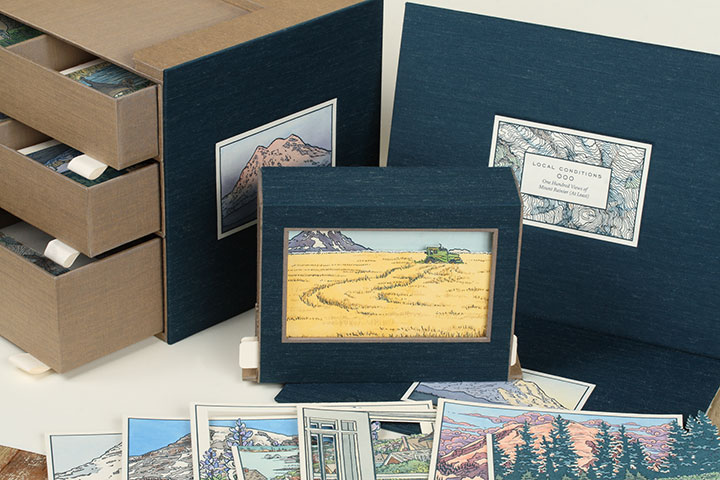
(Hint: a lot. Thousands. Millions. To be precise, 1.4 x 1015, or 1.4 quintillion, if you really wanted to push the envelope.)
• • • • • • • • • • • • • • • • • • • • • • • • • • • • • • • • • • • • • • • • • • • • • • • • • • • • • • • • • • • •
Local Conditions: One Hundred Views of Mt. Rainier (At Least)
Edition size: 26 numbered books and 5 roman-numeraled artist proofs
Book size: 10 x 8 x 8 inches when closed
Viewing window: 3 x 5 inches
Artist book consisting of viewing box and 120 image flats, illustrated and compiled from data collected in person, on location, over the course of two years. Housed in a set of drawers with nested stab-bound book and Japanese-style outer wrapper. Images and maps are hand-drawn, letterpress printed and individually hand-painted with watercolor. All image flats are hand-cut.
For price/purchase info, please contact me.
Edited to add (November 2011): As a supplement to the artist book, I also created a suite of 15 limited-edition letterpress prints, featuring some of my favorite scenes from the book. Just like the flats in the book, each print is letterpress printed and hand-painted with watercolor. You can find all 15 prints in the shop.
Colophon reads:
Japanese artist Katsushika Hokusai (1759 – 1849) is perhaps best known for his seminal works, Thirty-Six Views of Mount Fuji and One Hundred Views of Mt. Fuji. The two series of woodblock prints, published from 1829 to circa 1847, depict the sacred peak within the context of landscapes and scenes of daily life. At the heart of the series is Hokusai’s own obsession with immortality, and his fascination with Fuji’s eternal presence.
Therein lies the rub: Fuji is anything but eternal. Beyond the usual, abstract geologic transience of eroding rock and drifting continents, Fuji is an active stratovolcano. Its days—and those of the lives and lands at its base—are numbered.
Here in Washington state, just forty miles southeast of my home, lies Fuji’s taller, more volatile, American twin. Variously named Tacobet, Tahoma and Ti’Swaq’, among others, by the region’s indigenous peoples, or simply “The Mountain” by contemporary locals—its most arbitrary moniker, coined in 1792 by Captain George Vancouver, is the one that stuck: Mount Rainier.
It’s easy to forget Rainier’s impermanence. It has presided over thousands of years of indigenous culture, followed by the encroachment and permanent occupation of white settlers. It oversaw the construction of the Northern Pacific Railroad, the fever of the Klondike Gold Rush, the splendor of the Alaska-Yukon-Pacific Exposition. It stood in judgment while the American descendants of Hokusai’s countrymen were imprisoned beside the wooden-frame rollercoaster of the Western Washington Fairgrounds, at the internment center nicknamed Camp Harmony. And it has watched the rise and decline and rise again of Tacoma, the City of Destiny lovingly misnamed in its honor.
Yet all the while, Rainier has changed as much as the tableau at its feet. Its volcanic restlessness shifts its form, as our capricious Northwestern weather masks its appearance. It hides, or dominates, depending on the time of day or year. Even we have proved a catalyst, as our warming climate chases its alpine glaciers into retreat at the speed of industry.
And one day—whether tomorrow or in a million years, in an explosion of ash or by the erosion of time—Mount Rainier will disappear completely. I can’t begin to predict the future, but I can attempt to capture the present moment. One hundred present moments, to be exact. If nothing else, Local Conditions is a reminder of the lesson of this place: that here in the Ring of Fire, we never see the same Mountain twice.
* * *
Illustrated, designed, printed and bound by Chandler O’Leary, through freak snowstorms, record heat, and a thousand gentle rains in Tacoma, Washington. Each of the book’s 120 image flats is illustrated and compiled from sketches, photographs and data collected in person, on location, from September 2008 to October 2010. All text and images were letterpress printed in Hokusai’s indigo ink, down the street at Springtide Press. Images and topographic map patterns are hand-drawn and watercolored.
For making it possible to turn this crazy idea into an even crazier reality, many heartfelt thanks to Jessica Spring, Sarah Christianson, the Tacoma Arts Commission, the University of Puget Sound Collins Memorial Library, and the Book Arts Guild. Thanks also to the weather, for always, despite a notorious reputation, seeming to hold just long enough for me to grab the camera and jump in the car.
Produced with the support of a Tacoma Artists Initiative Program grant from the City of Tacoma Arts Commission.
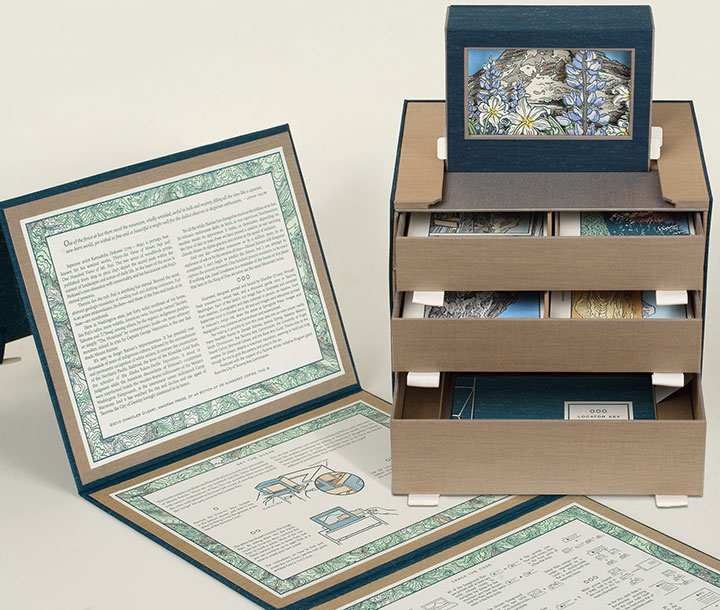
November 10th, 2010
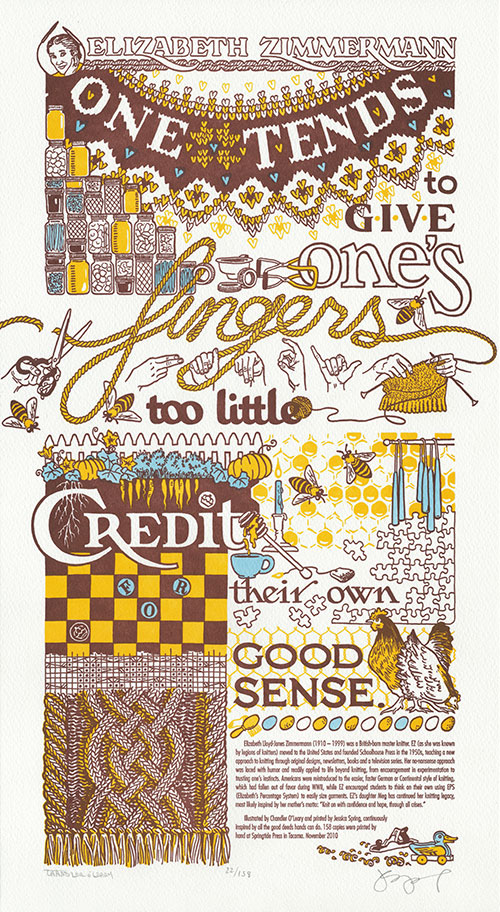
Maybe it’s the changing seasons. Or the fact that the farmers market runneth over with delicious autumn goodies. Or maybe we just wanted to talk about something that made us smile, for a change—because this time, for our tenth Dead Feminist broadside, Jessica and I have turned to a subject somewhat lighter of heart.
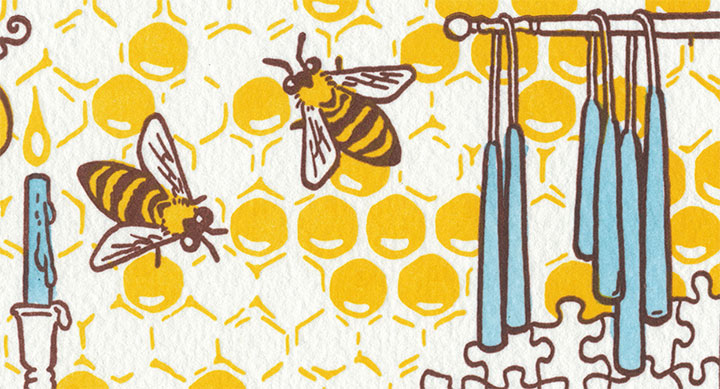
From the likes of urban homesteaders, artisans, D.I.Y.-ers, and hobbyists of all stripes, brilliant handiwork is all around us. We are in constant admiration of the power of one’s own two hands, and the good deeds they can do. And for the perfect symbol of a handmade life infused with joy and meaning, we’ve handed the microphone to Elizabeth Zimmermann:
One tends to give one’s fingers too little credit for their own good sense.

Now, as many of you probably know, Ms. Zimmermann was a knitter (that’s an understatement; I’d say more like All-Time Super-Queen Knitter of the Cosmos, Forever and Ever, Amen). But like every knitter, there is so, so much more to her than that. So rather than simply leaving it at yarn and wool, we discovered a cornucopia of the pursuits that fingers like to turn to when they’re not knitting. There are no idle hands here, to be sure.

Just in time for the fall harvest and in cozy preparation for the winter months ahead (or for our friends in the southern hemisphere, looking forward to a fruitful summer), Get Handy overflows with simple pleasures and home comforts. Elizabeth drafts a cable pattern and whips up a Fair Isle yoke. A little slow food takes root in the garden. Honeybees guard a new crop of candles. Fresh home-canned treats stock the shelves. Chickens scratch along a fence of golden (darning) eggs. Over a cup of tea, puzzles piece together and checkers crown kings. And when they’ve put down the yarn and scissors, the hands spell it out for you in American Sign Language.
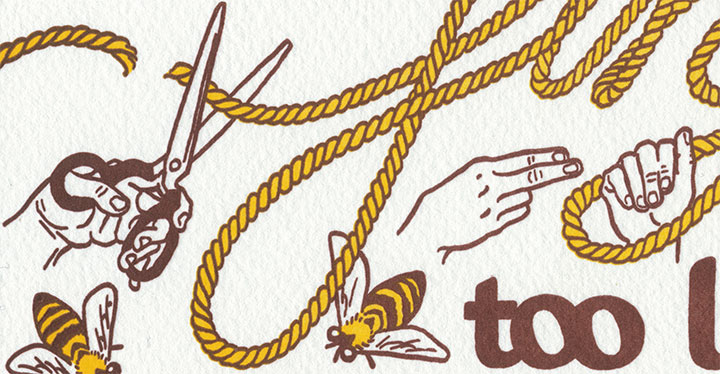
Oh, and the Tailor’s blueberries and Jessica’s dilly beans make a cameo appearance. Yum.

A portion of the proceeds from Get Handy will be donated to the amazing healing hands of Médecins Sans Frontières / Doctors Without Borders, via Tricoteuses Sans Frontières / Knitters Without Borders, which organizes knitters to raise funds for MSF/DWB. MSF, winner of the 1999 Nobel Peace Prize, is a medical relief organization dedicated to assisting people in distress around the world.
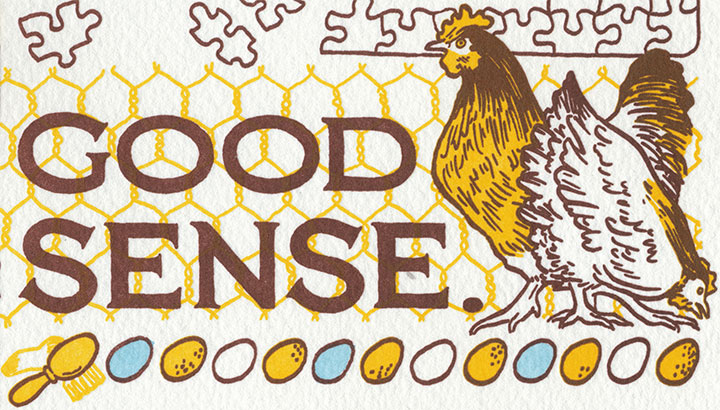
• • • • • • • • • • • • • • • • • • • • • • • • • • • • • • • • • • • • • • • • • • • • • • • • • • • • • • • • • • • •
Get Handy: No. 10 in the Dead Feminists series
Edition size: 158
Poster size: 10 x 18 inches
Printed on an antique Vandercook Universal One press, on archival, 100% rag paper. Each piece is hand-colored and signed by both artists.
Colophon reads:
Elizabeth Lloyd-Jones Zimmermann (1910 – 1999) was a British-born master knitter. EZ (as she was known by legions of knitters) moved to the United States and founded Schoolhouse Press in the 1950s, teaching a new approach to knitting through original designs, newsletters, books and a television series. Her no-nonsense approach was laced with humor and readily applied to life beyond knitting, from encouragement in experimentation to trusting one’s own instincts. Americans were reintroduced to the easier, faster German or Continental style of knitting, which had fallen out of favor during WWII, while EZ encouraged students to think on their own using EPS (Elizabeth’s Percentage System) to easily size garments. EZ’s daughter Meg had continued her knitting legacy, most likely inspired by her mother’s motto: “Knit on with confidence and hope, through all crises.”
UPDATE: poster is sold out. Reproduction postcards available in the Dead Feminists shop!

September 15th, 2010

Lately I’ve spent nearly every waking minute of each day with my face an inch away from the drafting table.
Let’s step back, and stretch out a bit.
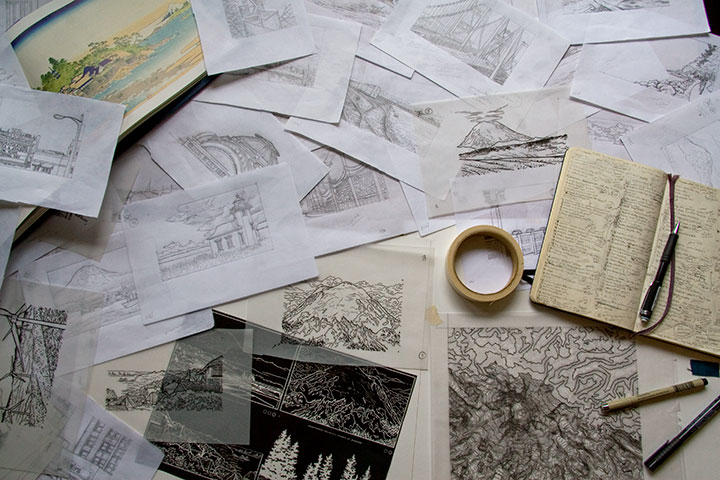
My studio is often a sea of papers—an occupational hazard—but these days the swells have consisted of pencil snapshots for my Mt. Rainier book. Dozens, and dozens, and dozens of them.
Time is ticking down, counting closer and closer to zero, and there are still many miles to cover before the clock strikes deadline. Yet suddenly, things are starting to come together. It won’t be long until I can share something that makes sense—something that looks more like a book, and less like a pile of drawings. I promise that you’ll be among the first to see it when I do.

But if I go missing for long stretches at a time—well, you know where to find me.
September 3rd, 2010
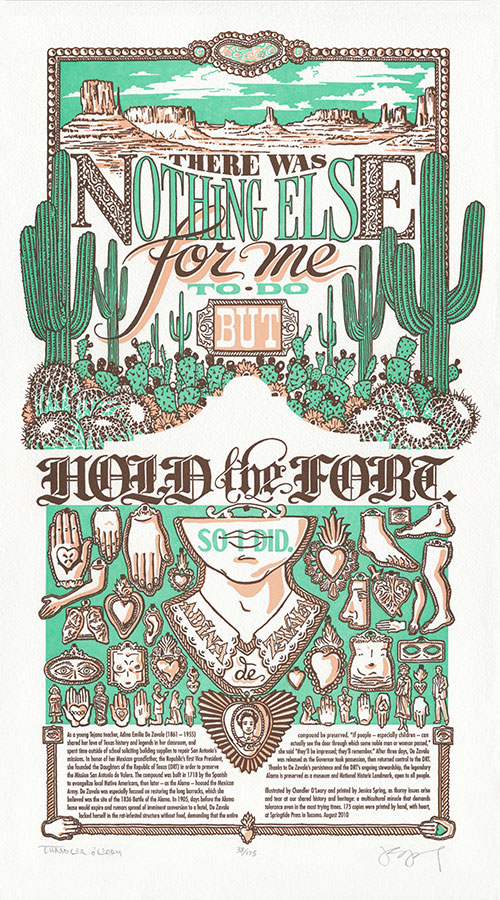
As autumn approaches and the inevitable rainy season knocks at our doors, Jessica and I are dreaming of the sunny skies of Arizona—where the not-so-sunny SB 1070, the state’s contentious new immigration reform bill, was signed into law earlier this year. At every turn, controversy pricks underfoot and looms overhead—with no easy, clear-cut answers in sight. So for our newest Dead Feminist broadside, we decided to challenge the controversy face-to-face-to-hand-to-heart with the words of Tejana activist Adina De Zavala:
There was nothing else for me to do but hold the fort. So I did.
In complete contrast with our last broadside, we had a short n’ sweet quote to work with this time—which gave me every reason and all kinds of room to go completely nuts with the imagery. I think my subconscious had a hand in steering us toward Adina and her quote, because I suddenly had the chance to explore a whole slew of filed-away themes and images that I had never been able to work into a piece before. My brain was swimming with ideas, and I found myself cackling out loud at the prospect of finally getting the chance to put so many of my favorite things into one crazy illustration. Green skies! Monument Valley! Mexican blackletter! Milagros! Cactus-spine fractal geometry! Mwa ha ha!
Ahem. I should probably back up the train a bit and give you the whole nerdy spiel.

On a Mission teems with icons of both the American Southwest and Mexican folk culture. A desert landscape—framed with metallic scrollwork and crazy-lace agate cabochons— stretches to the horizon, while saguaro sentinels tower over a tangled mess of prickly pears and barrel cacti. That was the easy part—thorny issue? Check.
The hard part was putting in all of our nebulous and conflicted feelings about the Alamo (represented here as an absence of imagery; a silhouette of negative space) and the topic at hand. So for answers I looked to Mexican folk art—so prominent on both sides of the Border, and so beautifully expressive, layered in history and meaning.
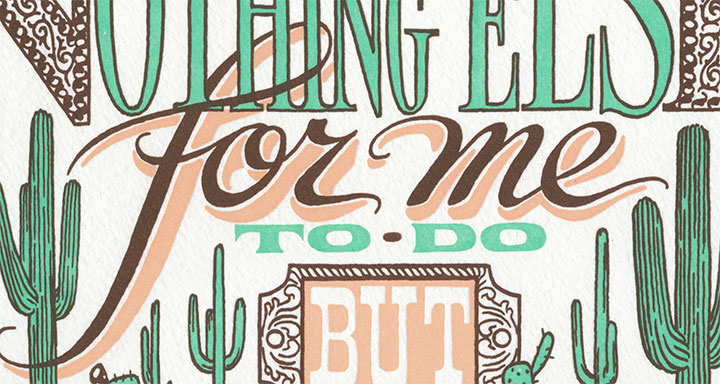
The text itself helped us get right to the point about that. The typography is influenced both by the American Old West and modern-day Mexico—particularly the latter. Mexico’s strong tradition of hand-lettering survives today, particularly in the form of hand-painted signs and advertisements. Inspiration ranged from the fluid folksiness of drop-shadowed cursive script—

—to the proud refinement of blackletter, a hold-out of the early Spanish colonial printers that has evolved to attain near-sacred importance in Mexican and Mexican-American popular culture. As we were conscious of our desire to “reclaim” some of the connotations behind the Alamo, blackletter provided the perfect weight and cultural twist to the phrase “Hold the fort.”
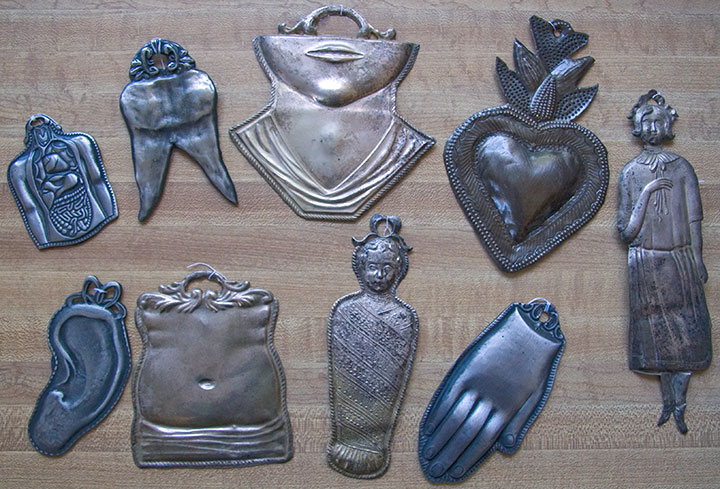
And then there’s my favorite part of the whole project: strewn all over the lower half of the illustration is a collection of milagros. Literally translated to “miracles,” milagros are small, stamped-metal votives that are typically hung in the shrines and churches of many Catholic countries—offered up in thanks for prayers answered and blessings received.
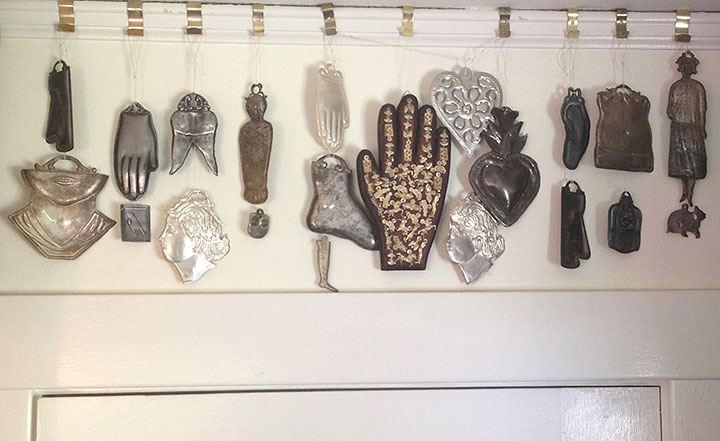
On my lifetime list of All-around Best Things Ever, milagros are very near the top—as evidenced by the growing collection in my studio. When I lived in Rome (where they are called ex votos), I used to pick them up on Sunday-mornings at the Porta Portese flea market for next to nothing. Ever since then, they’ve popped up in my work every now and then.
Well, now they get to be the stars of the show. If the Alamo were still the mission I picture in my head, the walls would be covered, floor to ceiling, with milagros. And since Adina herself has become a bit of a legend for her place in the Alamo’s history, illustrated devotionals adorn her name and portrait like pinned hopes.
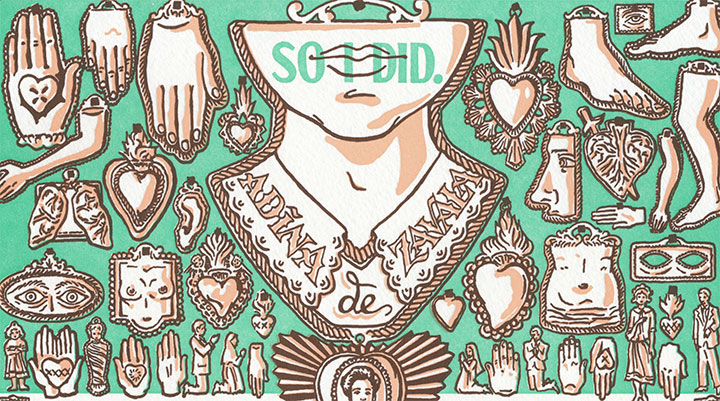
It may seem strange to get so giddily excited about illustrating such a serious topic, but somewhere along the way I realized that it’s that excitement over the positive that has given me perspective on the issue at hand. That what we think of as the “American” Southwest is so iconic and so dear to us because of the peoples with whom we share it. That the Southwest wouldn’t be what it is without its link to hundreds of years of both native and newcomer culture—just as America wouldn’t be America without immigration and cultural diversity. That keeping our multicultural vibrance alive is what makes us whole.
So in that spirit, a portion of the proceeds from On a Mission will be donated to the Northwest Immigrant Rights Project, a non-profit organization dedicated to promoting justice and legal rights for immigrants and refugees from more than 100 countries around the world.
I don’t know if any of this stuff crossed Adina De Zavala’s mind while she camped out inside the Alamo. She was just an individual who fought to keep an old, rotting building standing—and the place was a controversial symbol, even then (it certainly still is today). But she knew that the controversy was part of the legend of the place, and part of our heritage. And she knew the value of preserving that heritage for everyone’s benefit, without exception—so she held the fort. I think she deserves a few milagros on our wall for that.
• • • • • • • • • • • • • • • • • • • • • • • • • • • • • • • • • • • • • • • • • • • • • • • • • • • • • • • • • • • •
On a Mission: No. 9 in the Dead Feminists series
Edition size: 175
Poster size: 10 x 18 inches
Printed on an antique Vandercook Universal One press, on archival, 100% rag paper. Each piece is signed by both artists.
Colophon reads:
As a young Tejana teacher, Adina Emilia De Zavala (1861 – 1955) shared her love of Texas history and legends in her classroom, and spent time outside of school soliciting building supplies to repair San Antonio’s missions. In honor of her Mexican grandfather, the Republic’s first Vice President, she founded the Daughters of the Republic of Texas (DRT) in order to preserve the Mission San Antonio de Valero. The compound was built in 1718 by the Spanish to evangelize local Native Americans, then later—as the Alamo—housed the Mexican Army. De Zavala was especially focused on restoring the long barracks, which she believed was the site of the 1836 Battle of the Alamo. In 1905, days before the Alamo lease would expire and rumors spread of imminent conversion to a hotel, De Zavala locked herself in the rat-infested structure without food, demanding that the entire compound be preserved. “If people—especially children—can actually see the door through which some noble man or woman passed,” she said, “they’ll be impressed; they’ll remember.” After three days, De Zavala was released as the Governor took possession, then returned control to the DRT. Thanks to De Zavala’s persistence and the DRT’s ongoing stewardship, the legendary Alamo is preserved as a museum and National Historic Landmark, open to all people.
Illustrated by Chandler O’Leary and printed by Jessica Spring, as thorny issues arise and tear at our shared history and heritage: a multicultural miracle that demands tolerance even in the most trying times. 175 copies were printed by hand, with heart, at Springtide Press in Tacoma. August 2010
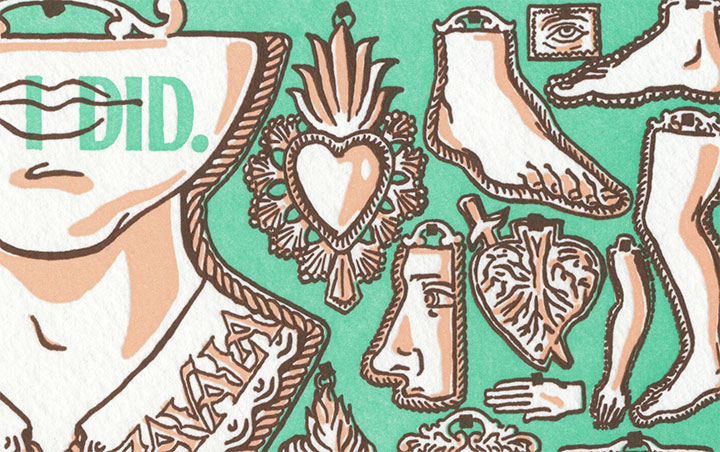
UPDATE: poster is sold out. Reproduction postcards available in the Dead Feminists shop!
August 31st, 2010
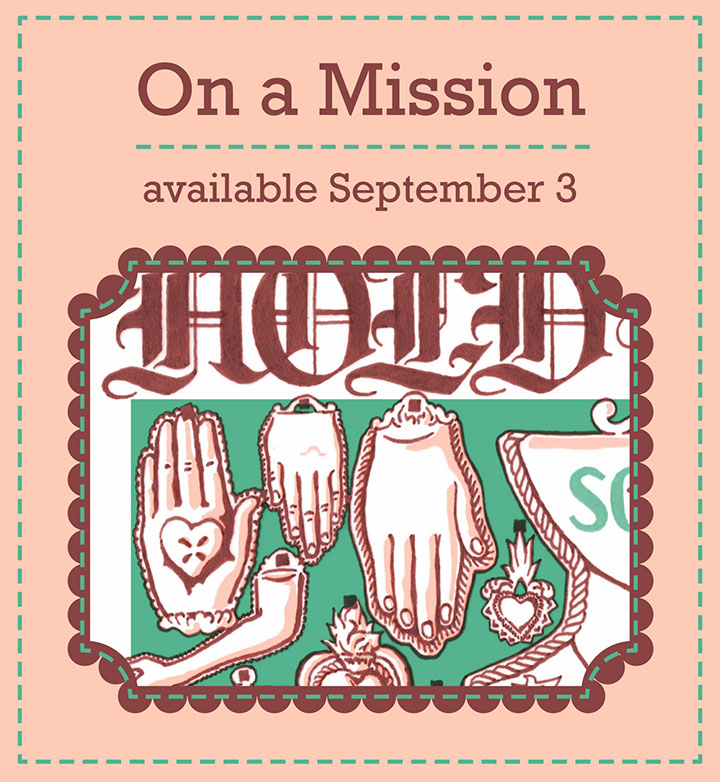
At the Wayzgoose on Saturday (thanks to the hundreds of folks who showed up!), Jessica and I had a little teaser for the next Dead Feminist print set up at our table—I figured it wouldn’t be fair if I didn’t also share it online.
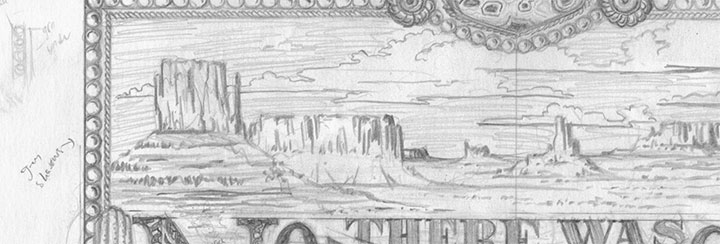
I’m not going to say much, so as not to spoil the surprise, but I thought I’d drop a few clues by way of my messy drawings—
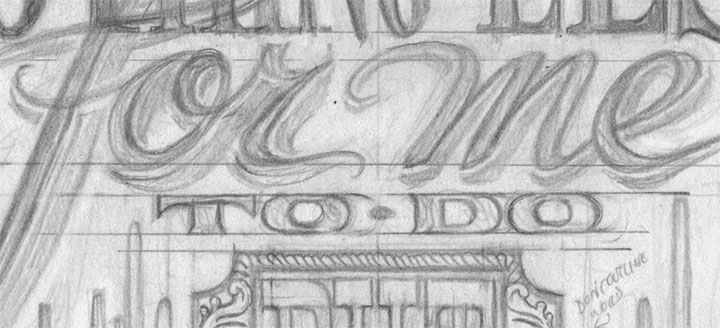
warts and all. As you can see by all the smudges and arrows, doin’ it by hand is hardly a perfect process,
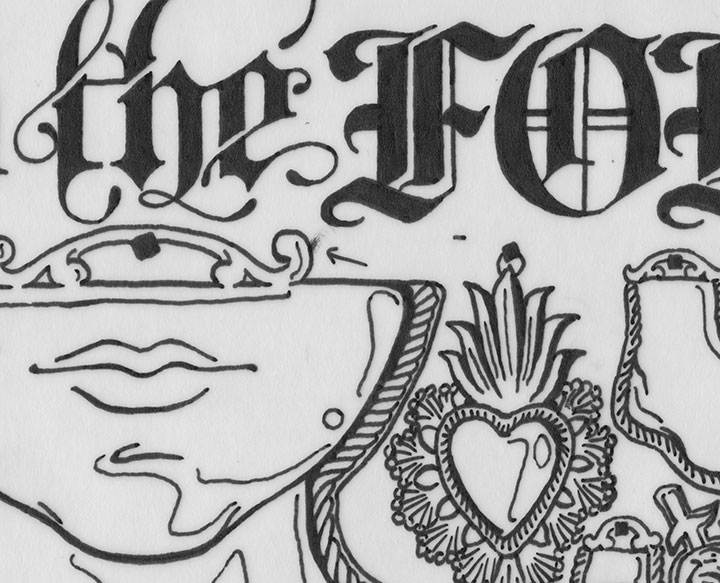
but I wouldn’t have it any other way.
On a Mission is on press as I speak, inching closer to the finish line every moment. Look for it here on Friday—see you then!
August 25th, 2010
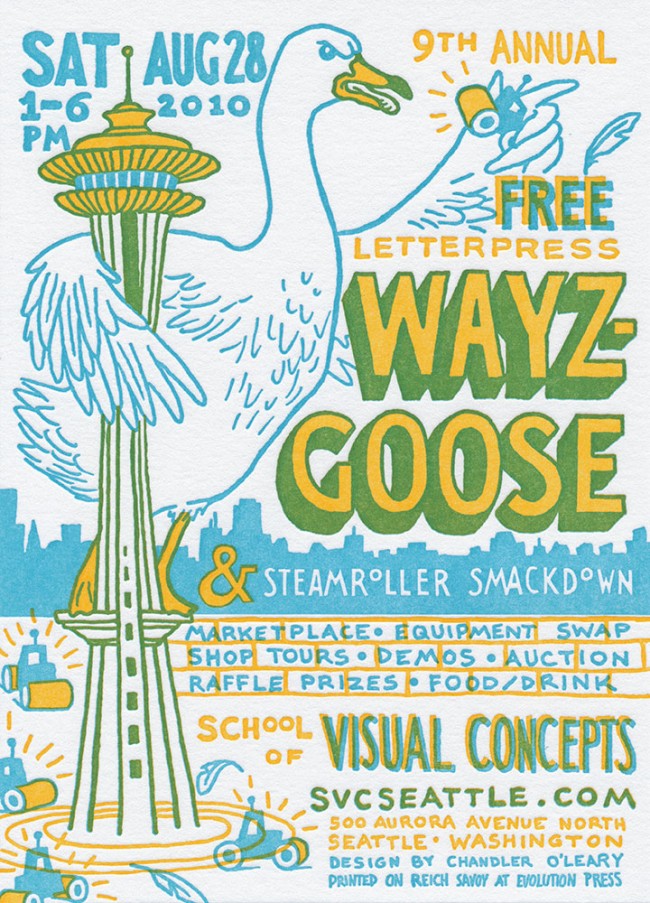
Jessica and I are waist-deep in the new Dead Feminist print (look for it here next week), so I’m just popping in to wave hello—and to warn you, in badly-dubbed English, about the giant goose climbing the Space Needle.
Just kidding … but they will be sending in the steamrollers. This Saturday, in the Needle’s mighty shadow, is Seattle’s biggest letterpress party of the year: Wayzgoose. The weather is supposed to be perfect, so come on over and say hi to scads of letterpress artists, print your very own keepsake in the studios, and referee the Steamroller Smackdown outside. Jessica and I won’t be steamrolling this time, but we will have a table in the marketplace—so don’t be a stranger!
Here’s the skinny:
9th Annual Seattle Wayzgoose
Saturday, August 28, 2010
1 to 6 pm
Free!
School of Visual Concepts
500 Aurora Avenue North, Seattle
More information and RSVP here
The lovely ‘Goose wranglers at SVC asked me to design this year’s postcard; I think I was watching too many Japanese monster movies at the time. But monsters and letterpress seem to go well together; the postcard is lovingly letterpress printed by the talented titans at Evolution Press
August 21st, 2010
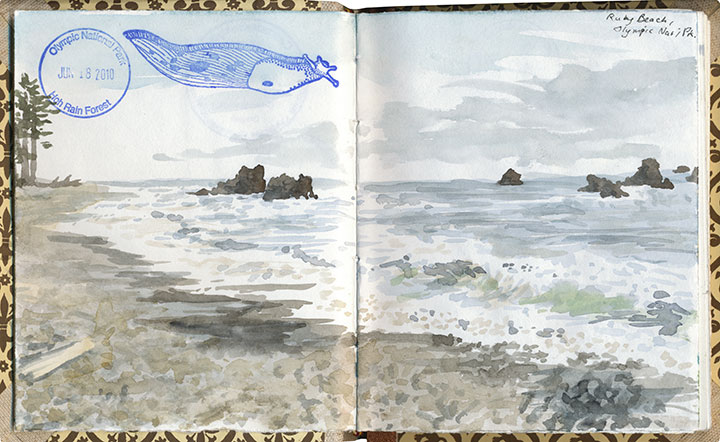
Since I posted this drawing and some others this summer, people have been asking me what’s with the stamps in my sketchbook. I guess the short answer is that each one is a little piece of personal tradition.
But you know I don’t really do short answers.
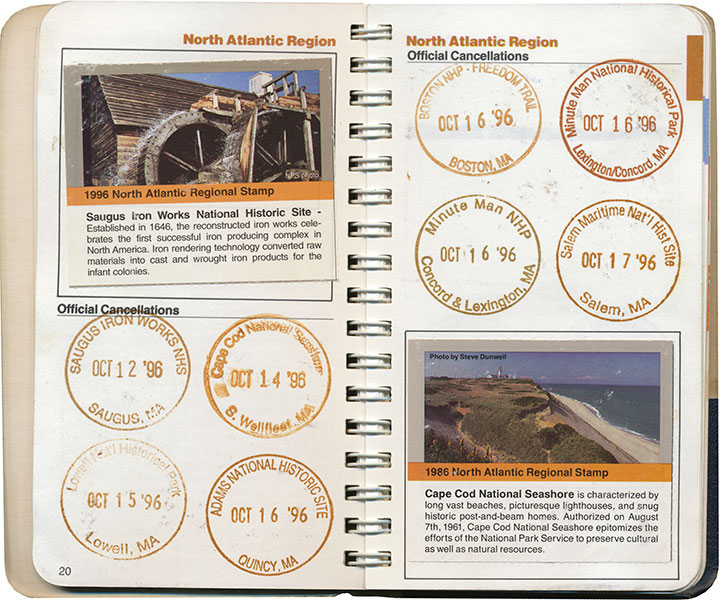
The long one, then.
I grew up in a nomadic family. Between the moves required by Dad’s job in the Air Force and a fierce wanderlust that runs in all the O’Leary veins, we had a lot of reasons to travel. Dad and I, especially, would spend hours poring over our dog-eared Rand McNally road atlas, plotting routes over the back-est of back roads (the squigglier the line on the map, the better) and stops at as many points of interests as we could cram into a journey from A to B.
When I was ten, we made a circuit of our then-home state of Colorado, and devoted our time to exploring every national park and monument we could reach along the loop. At each park’s visitor center, we noticed a rubber stamp and ink pad stationed at the front desk. When we finally asked a ranger what they were for, she handed us a small blue notebook and proceeded to explain about the National Park Service’s Passport program.
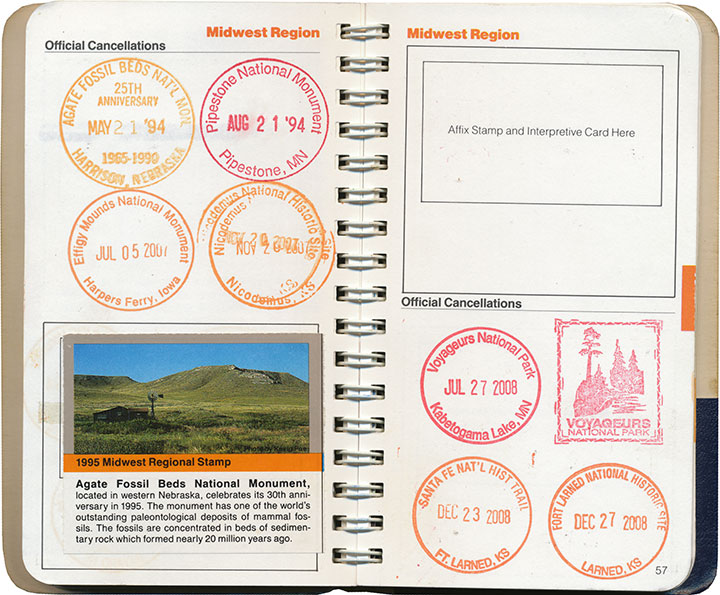
A stamp to collect at every NPS property in the country, and a tidy little book to hold them all? I was hooked.
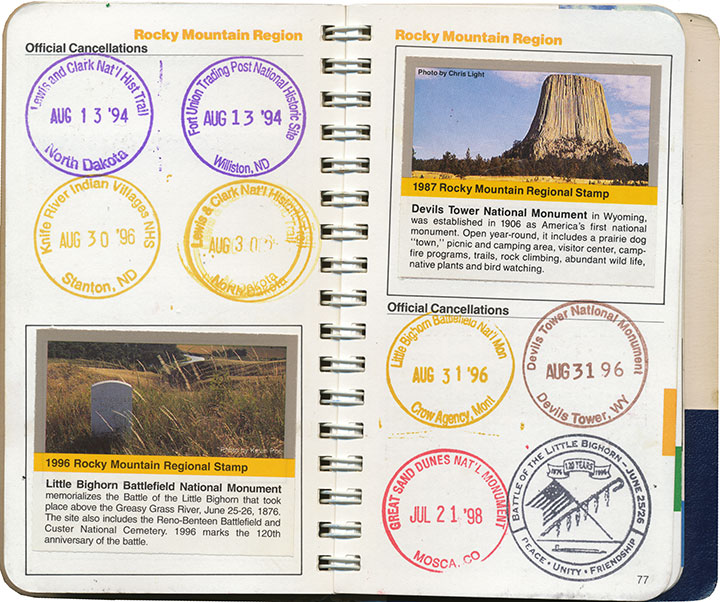
Dad and I found ways to sneak a national monument or two into every road trip and relocation—and even took impromptu vacations just to add a new park to the list. My favorite memory is when I was in high school, and Dad popped his head into my room:
“Have any plans this weekend?”
“Uh, no…”
“Wanna go to Montana?”
So we jumped in the car and drove 600 miles just to flip General Custer the bird at Little Bighorn (I had just read Bury My Heart at Wounded Knee, so he wasn’t exactly stirring me to patriotism). I mean, if you’re going to do it, you might as well go all out, after all. And we had the stamp to commemorate the moment.
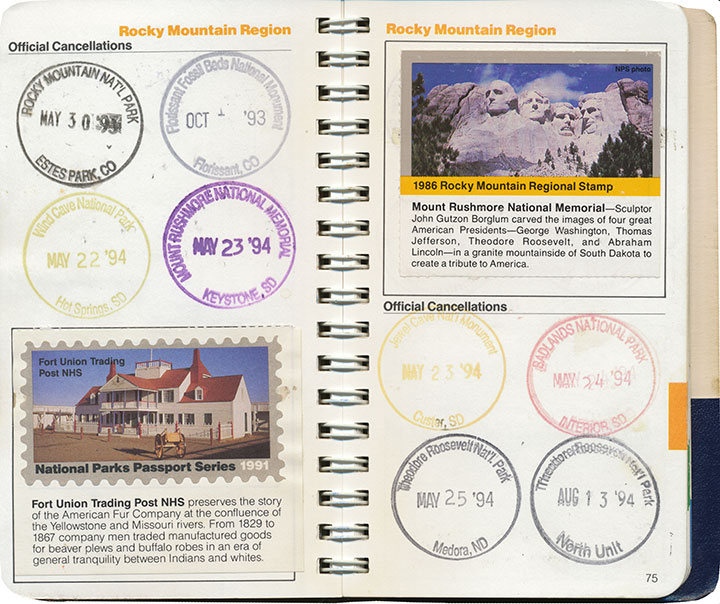
The Passport program also includes collectible paper stamps, which can be purchased from afar (as opposed to the ink cancellations, which are free but can only be obtained in person). I’m pretty lukewarm about these, though; by the time I jumped on the bandwagon they had already phased out the super-cool two-piece design pictured in the lower left corner above, in favor of the cheaper, lower-quality one-piece stamp in the upper right. Since those have been revamped yet again into a pressure-adhesive sticker—and who knows what heinously non-archival chemicals might be in the glue—I’m even less of a completist about them now.
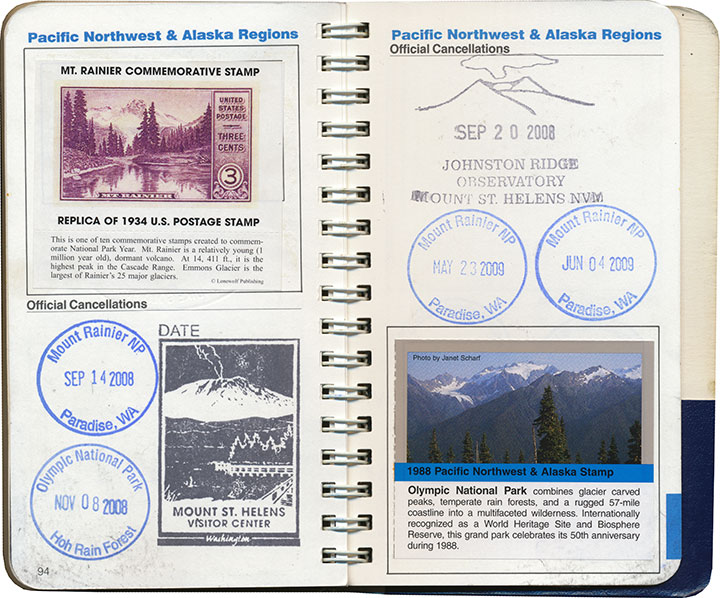
Anyway, I’ve burned through most of the regional sections in my Passport,
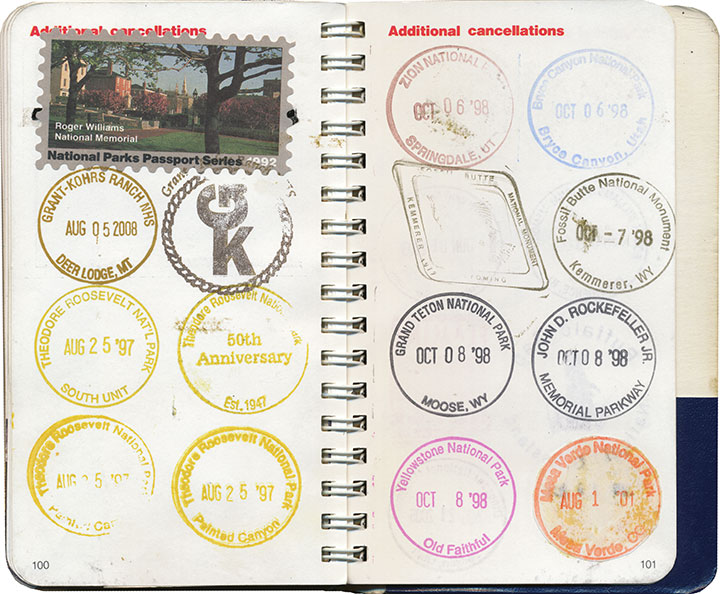
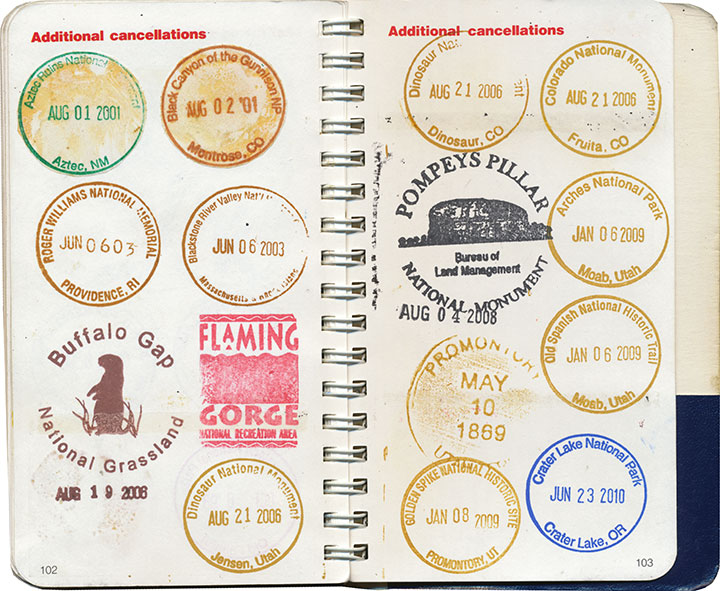
and every inch of overflow space.
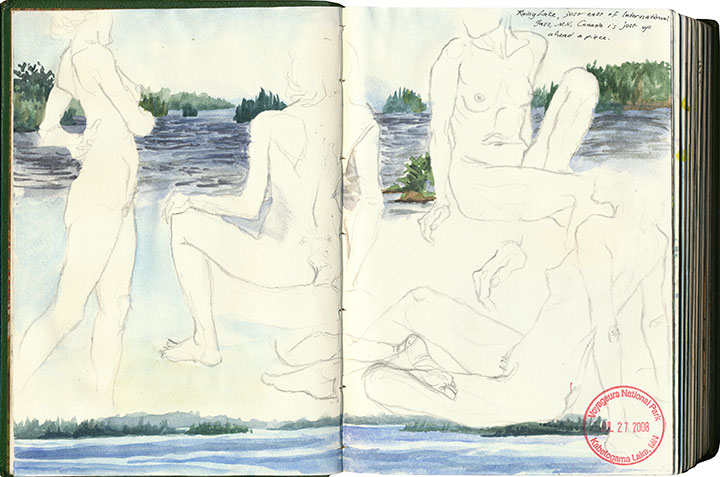
So I’ve branched out a bit.
What I didn’t know as a kid was that my Passport helped me develop my interest in nearly everything I love most: traveling, design, archiving, printmaking, history, typography, bookmaking, and so on.
At some point along the way, I realized that what I really mattered to me (beyond the travel itself) was the act of adding to an ongoing work—and then looking back to see what I had accomplished. That what I had been doing all along, by compiling this little individual history, is creating some form of artist book. And that my frustrations over an imperfect format were really a desire to create my own.
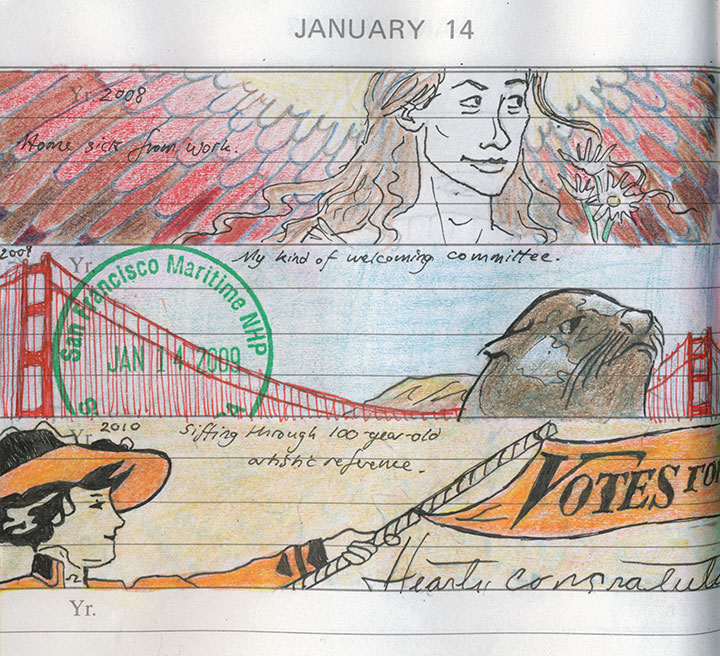
A page from my daily book—more on that here.
So now all of my sketchbooks are Passports, each custom-tailored—
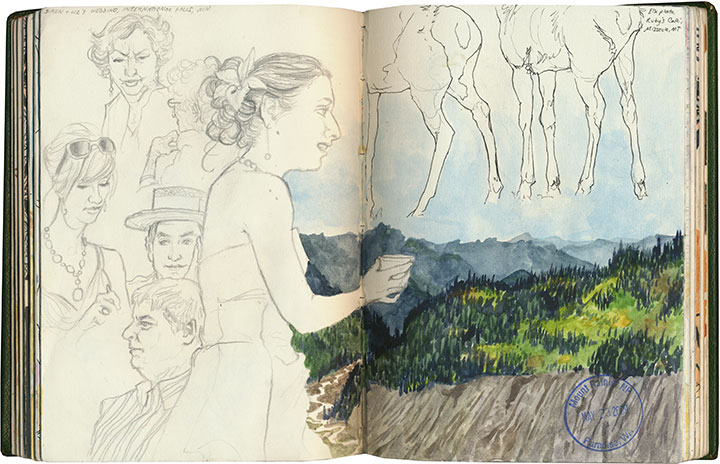
each infinitely flexible, ready for whatever adventures wait to be documented.

Here it is, nearly twenty years later, and I’m as eager as ever. Moreover, it’s my goal to collect every last cancellation within the entire National Park System before I stamp the big passport book in the sky. I’m about a quarter of the way there.
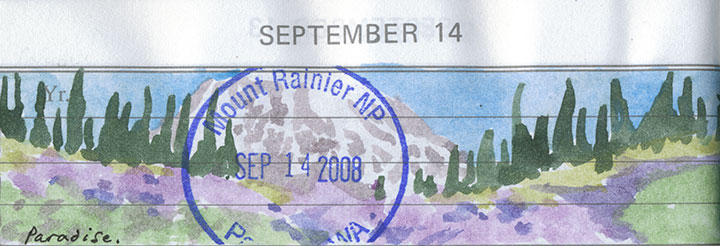
And I’ll probably have to build a library for all the sketchbooks I’ll fill between now and then.
Save
August 11th, 2010
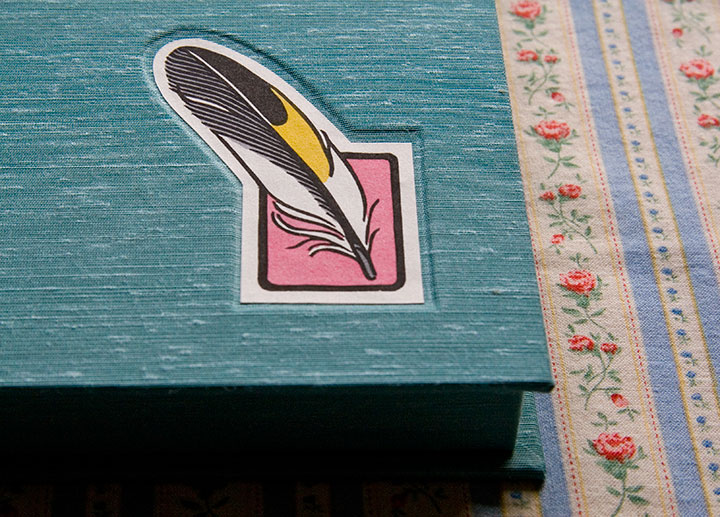
I’ve been sitting on this post for months now—it’s just that after spending so much time hunched over this project, I needed some time off from even thinking about it. But now I’m ready to talk birds again.

From left: Cedar Waxwing; Steller’s Jay; American Avocet; Purple Martin; Tufted Puffin
Eighteen months, twenty-five birds, six hundred twenty-five individual prints and ten box sets later, my little Flock is finished.

Mountain Quail; American Bittern; Long-billed Curlew; Hooded Merganser; Laysan Albatross

Barn Owl; American Kestrel; Eurasian Coot; Anna’s Hummingbird; Herring Gull
It’s a little crazy to see these all together, like, well, birds on a wire. Each one has been broken down into its own little assembly line for so long that I forget sometimes to see them as a set.

Western Tanager; Lazuli Bunting; Northern Flicker; Bullock’s Oriole; Belted Kingfisher

Common Loon; Marbled Murrelet; Northern Shoveler; Harlequin Duck; Brown Pelican
As you can see, what’s represented here is a pretty broad cross-section of Washington birds. There are so many bird species ’round these parts, in fact, that I almost didn’t know where to start—and narrowing the choices down to twenty-five was by far the most difficult task.
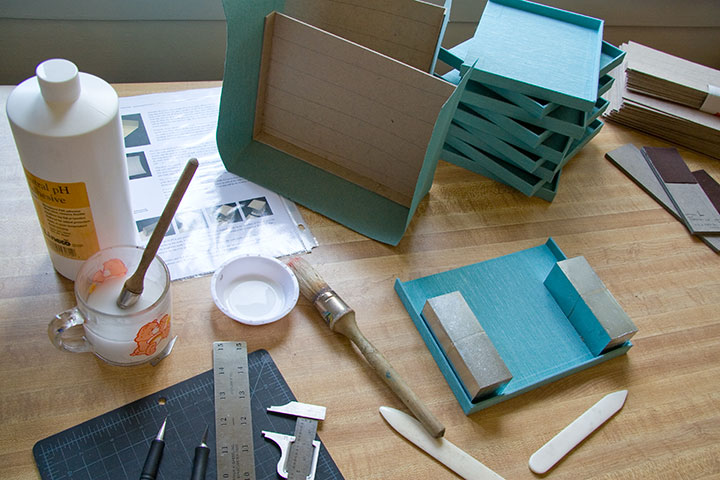
Wait. I take that back. The hardest part was keeping the glue off of the pricey imported Japanese book cloth (glue plus cloth equals death—or at least wailing, gnashing of teeth, and starting all over from the beginning).

You see, it seemed silly to have a set of prints with nothing to house it. My inner book artist took over (thanks to Jessica’s tricksy enabling), and insisted on encasing the first ten sets of the edition in handmade clamshell boxes.

Even though the results are always worth it, I don’t have much love for making boxes—what I do love is printing the colophon. A colophon (or in today’s hardbound novels, the “note on the text”) is an essential element in any artist’s book; this is where the artist steps outside the book’s content and talks about the making of the book itself. For this I decided to go back to my letterpress roots, and hand-set the text in metal type.
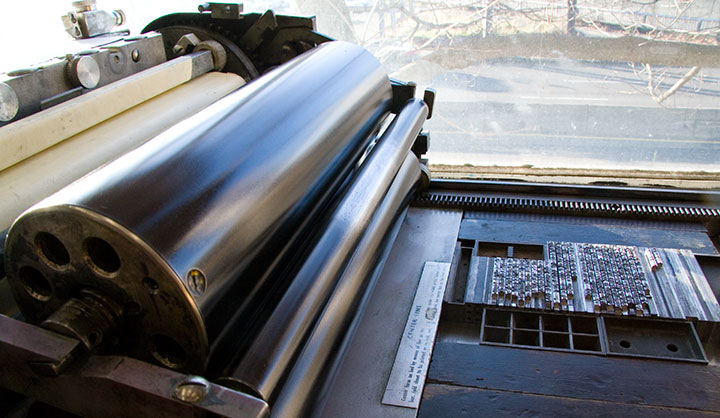
While I’m rarely able to fit hand-setting into my projects these days (a drawback to all the lettering I’ve been doing), it’s still my favorite method of getting a block of text onto a page. And this beloved Bembo, cast locally at Stern & Faye, is so beautifully spaced and balanced that it’s a dream to set and a pleasure to read.
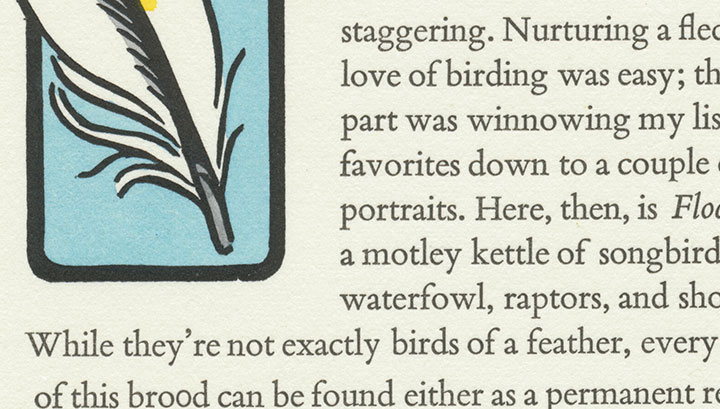

Here’s what it says:
The sheer variety of avian species here in the Pacific Northwest is staggering. Nurturing a fledgling love of birding was easy; the hard part was winnowing my list of favorites down to a couple dozen portraits. Here, then, is Flock, a motley kettle of songbirds, waterfowl, raptors, and shorebirds. While they’re not exactly birds of a feather, every member of this brood can be found either as a permanent resident or a passing traveler in Washington state—with just a wingtip of artistic license, that is.
Printed from October 2008 to December 2009 on a gaggle of presses, including Vandercook models SP15 and Universal One, a Craftsman 6.5 x 10 platen, and my little Kelsey 3 x 5—at the School of Visual Concepts in Seattle, Springtide Press in Tacoma, the University of Puget Sound, and here at Anagram Press, respectively. The colophon is hand-set in Bembo, and each hand-carved linocut print is hand-painted with Pelikan watercolor (no pun intended). Of a covey of 25 birds, a tweet of 25 prints each, and a parliament of ten box nests, this is number [2].
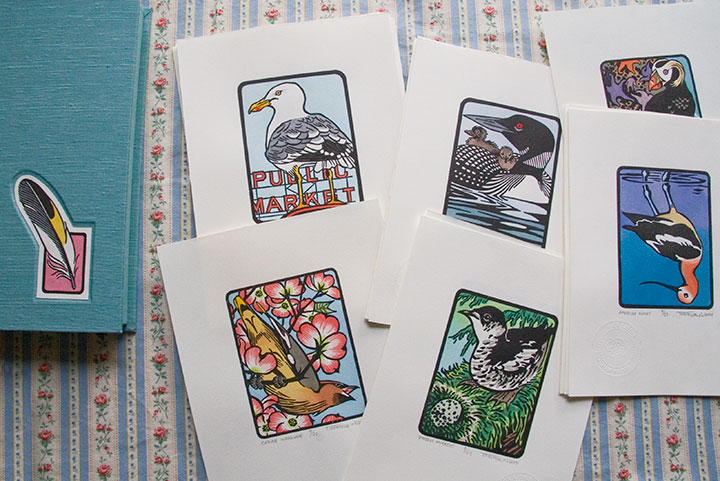
Okay, so maybe I went a bit overboard on the avian puns. It’s just that the thought of getting my hands dirty on type drawers again had me all twitterpated.
And I have a fluttering feeling that there might be even more birds in my future—one of these days, anyway.
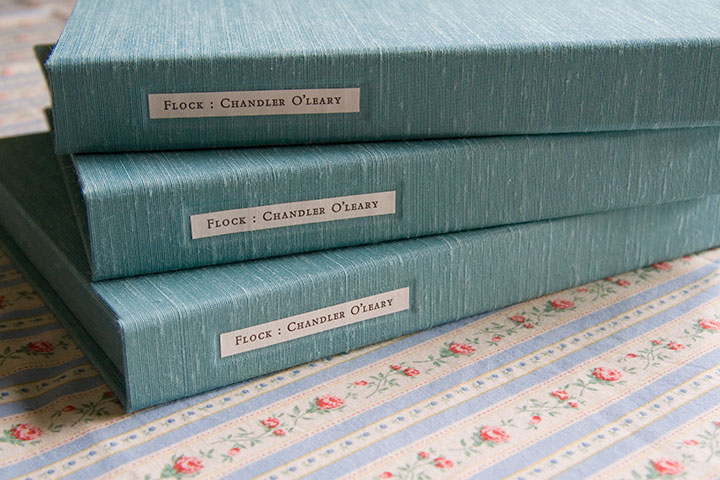
June 24th, 2010
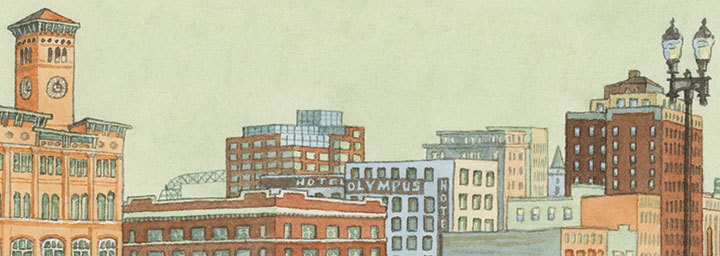
I did this little watercolor as part of a commissioned project that ended up being canceled. I’m a little sad the project won’t see the light of day, but the morning I spent sketching downtown will always be time well spent.
June 9th, 2010
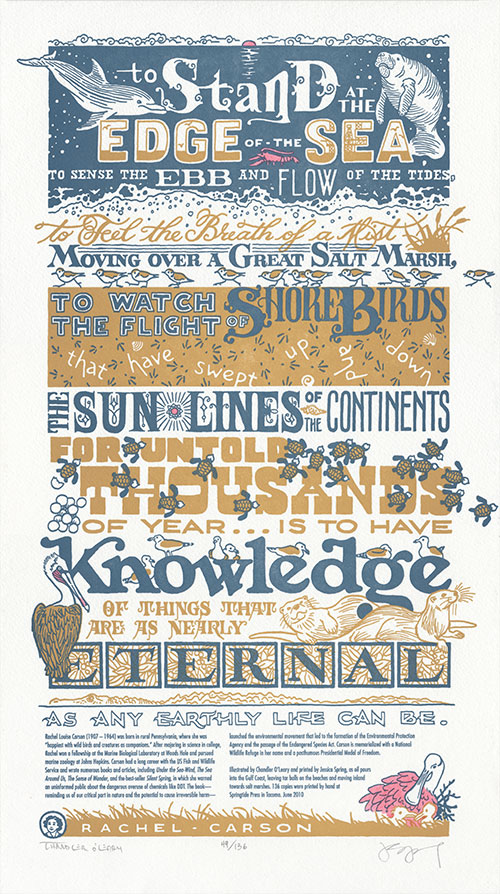
Okay, I know the title is a bit controversial. But it was either that or something laden with obscenities—Jessica and I are feeling murderous less than charitable towards the oil industry at the moment. Thus far the Deepwater Horizon/British Petroleum oil “spill” (leak? deluge? hemorrhage?) has poured tens of millions of gallons of oil into the Gulf of Mexico—a fact that stopped us in our tracks, mid-way through a different piece, and changed our course for this season’s broadside.
I wish I could say this was a fun piece to create; dwelling on current events and spending days poring through images of oil-soaked animals has been one of the most depressing, enraging experiences I’ve had in my career. Luckily, I could spend the rest of my energy drawing the inspiring quote by writer, scientist and environmentalist Rachel Carson:
“To stand at the edge of the sea, to sense the ebb and flow of the tides, to feel the breath of a mist moving over a great salt marsh, to watch the flight of shore birds that have swept up and down the sun lines of the continents for untold thousands of year* … is to have knowledge of things that are as nearly eternal as any earthly life can be.”
(*not a typo, I promise.)
This is by far the longest quote we’ve tackled yet, and I needed convincing before I could justify the pins and needles I’d feel in my hand afterward. But along the way, it occurred to me that the quote reads like a poem—with a rhythm that opened up all kinds of image possibilities.

I couldn’t face the idea of drawing any of the oil spill’s destruction, so I chose instead to focus on the wildlife affected by the spill—including several already-endangered species—and create an image absolutely teeming with life. A manatee and dolphin play in deep ocean blue, while plovers dash by in a sandy gold that becomes the sickly tea-colored oil pouring from a hidden offshore rig (okay, so maybe a little of my anger found its way into the drawing). Baby sea turtles inch their way to the shore; a roseate spoonbill nests in a corner; a brown pelican sits, surveying the scene. How many creatures can you find?
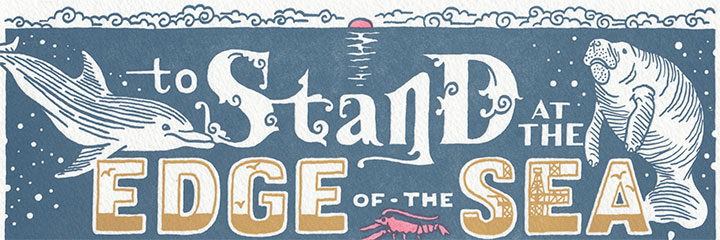
One positive note that we can hold onto is the hope that we might make a bit of difference with our art. Our Dead Feminists have made their way to 40 states and 9 countries outside the U.S., so the word is definitely spreading. And we’ll be donating a portion of the proceeds from Drill, Baby, Drill to Oceana, an international organization focused on ocean conservation and dedicated to ending offshore drilling.
There. I said it. We want to ban offshore drilling outright. Forever.
I don’t mean to offend any readers on the other side of that particular fence (if any are left; sometimes I wonder if our series hasn’t already alienated half of the population…), but this is one issue around which I simply cannot tiptoe.
But then again, Rachel Carson wouldn’t have, either.
• • • • • • • • • • • • • • • • • • • • • • • • • • • • • • • • • • • • • • • • • • • • • • • • • • • • • • • • • • • •
Drill, Baby, Drill: No. 8 in the Dead Feminists series
Edition size: 136
Poster size: 10 x 18 inches
Printed on an antique Vandercook Universal One press, on archival, 100% rag paper. Each piece is hand-colored and signed by both artists.
Colophon reads:
Rachel Louise Carson (1907 – 1964) was born in rural Pennsylvania, where she was “happiest with wild birds and creatures as companions.” After majoring in science in college, Rachel won a fellowship at the Marine Biological Laboratory at Woods Hole and pursued marine zoology at Johns Hopkins. Carson had a long career with the US Fish and Wildlife Service and wrote numerous books and articles, including Under the Sea-Wind, The Sea Around Us, The Sense of Wonder, and the best-seller Silent Spring, in which she warned an uninformed public about the dangerous overuse of chemicals like DDT. The book—reminding us of our critical part in nature and the potential to cause irreversible harm—launched the environmental movement that led to the formation of the Environmental Protection Agency and the passage of the Endangered Species Act. Carson is memorialized with a National Wildlife Refuge in her name and a posthumous Presidential Medal of Freedom.
Illustrated by Chandler O’Leary and printed by Jessica Spring, as oil pours into the Gulf Coast, leaving tar balls on the beaches and moving inland towards salt marshes. 136 copies were printed by hand at Springtide Press in Tacoma. June 2010
UPDATE: poster is sold out. Reproduction postcards available in the Dead Feminists shop!


![Chandler O'Leary [logo]](https://chandleroleary.com/wp-content/themes/chandleroleary/images/logo.png)







































































